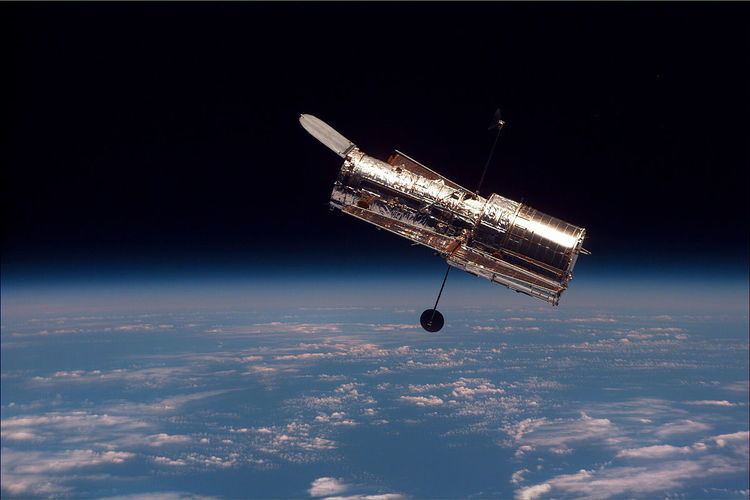 | ||
This list of space telescopes (astronomical space observatories) is grouped by major frequency ranges: gamma ray, x-ray, ultraviolet, visible, infrared, microwave and radio. Telescopes that work in multiple frequency bands are included in all of the appropriate sections. Space telescopes that collect particles, such as cosmic ray nuclei and/or electrons, as well as instruments that aim to detect gravitational waves, are also listed. Missions with specific targets within the Solar System (e.g. our Sun and its planets), are excluded; see List of Solar System probes for these, and List of Earth observation satellites for missions targeting our planet.
Contents
- Gamma ray
- X ray
- Ultraviolet
- Visible
- Infrared and submillimetre
- Microwave
- Radio
- Particle detection
- Gravitational waves
- To be launched
- Proposed
- References
Two values are provided for the dimensions of the initial orbit. For telescopes in Earth orbit, the min and max altitude are given in kilometers. For telescopes in solar orbit, the minimum distance (periapsis) and the maximum distance (apoapsis) between the telescope and the center of mass of the sun are given in astronomical units (AU).
Gamma ray
Gamma ray telescopes collect and measure individual, high energy gamma rays from astrophysical sources. These are absorbed by the atmosphere, requiring that observations are done by high-altitude balloons or space missions. Gamma rays can be generated by supernovae, neutron stars, pulsars and black holes. Gamma ray bursts, with extremely high energies, have also been detected but have yet to be identified.
X-ray
X-ray telescopes measure high-energy photons called X-rays. These can not travel a long distance through the atmosphere, meaning that they can only be observed high in the atmosphere or in space. Several types of astrophysical objects emit X-rays, from galaxy clusters, through black holes in active galactic nuclei to galactic objects such as supernova remnants, stars, and binary stars containing a white dwarf (cataclysmic variable stars), neutron star or black hole (X-ray binaries). Some Solar System bodies emit X-rays, the most notable being the Moon, although most of the X-ray brightness of the Moon arises from reflected solar X-rays. A combination of many unresolved X-ray sources is thought to produce the observed X-ray background.
Ultraviolet
Ultraviolet telescopes make observations at ultraviolet wavelengths, i.e. between approximately 10 and 320 nm. Light at these wavelengths is absorbed by the Earth's atmosphere, so observations at these wavelengths must be performed from the upper atmosphere or from space. Objects emitting ultraviolet radiation include the Sun, other stars and galaxies.
UV ranges listed at Ultraviolet astronomy#Ultraviolet space telescopes.
Visible
The oldest form of astronomy, optical or visible-light astronomy extends from approximately 400 to 700 nm. Positioning an optical telescope in space means that the telescope does not see any atmospheric effects (see astronomical seeing), providing higher resolution images. Optical telescopes are used to look at stars, galaxies, planetary nebulae and protoplanetary disks, amongst many other things.
Infrared and submillimetre
Infrared light is of lower energy than visible light, hence is emitted by cooler objects. As such, the following can be viewed in the infrared: cool stars (including brown dwarves), nebulae, and redshifted galaxies.
Microwave
Microwave space telescopes have primarily been used to measure cosmological parameters from the Cosmic Microwave Background. They also measure synchrotron radiation, free-free emission and spinning dust from our Galaxy, as well as extragalactic compact sources and galaxy clusters through the Sunyaev-Zel'dovich effect.
Radio
As the atmosphere is transparent for radio waves, radio telescopes in space are of most use for Very Long Baseline Interferometry; doing simultaneous observations of a source with both a satellite and a ground-based telescope and by correlating their signals to simulate a radio telescope the size of the separation between the two telescopes. Observations can be of supernova remnants, masers, gravitational lenses, starburst galaxies, and many other things.
Particle detection
Spacecraft and space-based modules that do particle detection, looking for cosmic rays and electrons. These can be emitted by the sun (Solar Energetic Particles), our galaxy (Galactic cosmic rays) and extragalactic sources (Extragalactic cosmic rays). There are also Ultra-high-energy cosmic rays from active galactic nuclei, those can be detected by ground-based detectors via their particle showers.
Gravitational waves
A proposed new type of telescope is one that detects gravitational waves; ripples in space-time generated by colliding neutron stars and black holes.
To be launched
Not in space yet:
Proposed
List of proposed space observatories: examples of past and present space observatory plans, concepts, and proposals. For observatories in orbit see, List of space telescopes.
